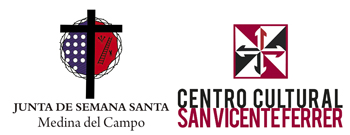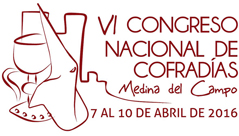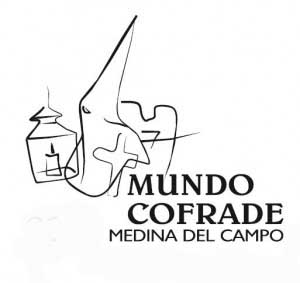THE PROCESSIONS,TODAY
THE PROCESSIONS
WEDNESDAY (WEDNESDAY BEFORE HOLY THURSDAY)
Childish VíaCrucis (18.00h)
Departure-Arrival: Nuestra Señora del Carmen Shrine
Description: The children of the Saint John of de Cross school represent the passion of Christ, and they are accompanied the children of the different brotherhood.
FRIDAY. VIERNES DE DOLORES (FRIDAY BEFORE HOLY FRIDAY)
Procession of Ntra. Sra. de las Angustias
(the procession starts just after the ending of the mass (Not before 21.15 hours)
Departure-Arrival: Collegiate Church of Saint Antolín
Paso (float): Ntra. Sra. de las Angustias (anonymous, 16th Century)
Description: The image of Nuestra Señora de las Angustias, patron saint and permanent Mayoress of Medina del Campo, is accompanied during the procession by the brotherhood Archicofradía de Nuestra Señora de las Angustias, carrying the Staff of Power that has been previously handed over by the Mayoress of the city. Due to the strong devotion that people from Medina feel to this image, traditionally known as “the Painful Virgin”, a Salve or Hail Mary is sung when the image of the Virgin Mary reaches the church.
SATURDAY.PASSION SATURDAY
Professional moving of Jesus the Nazarene (20.00 hours)
Departure-Arrival: San Roque Chapel – Amparo Chapel
Paso (float): Nazareno de la Cruz “Nazarene of the Cross” (Castilian School), 17th century; Cruz Guía- Crucificado de la Vera Cruz (Anonymous, 16th century)
Description: The brotherhood la Misericordia y Jesús Nazareno and its music band accompany two processional images: la Cruz Guía – Crucificado de la Vera Cruz (anonymous, 16th Century) and el Nazareno de la Cruz (Castilian School, 17th century).
The Nazarene of the Cross is commonly known in Medina as “Nazareno Pequeño” (“Small Nazarene”) due to its small size (85cm). It is great masterpiece made using the wood carving technique for the feet, hands and head. The rest of the image is made of papelón, a technique that mixes paper, cardboard, and glued clothing to give shape to the images. It is one of the few processional images made of papelón that has arrived to our days and can be still seen in a procession.
SUNDAY, PALM SUNDAY
Procession of La Borriquilla (11 hours)
Departure-Arrival: Santiago el Real Church
Paso (float): La Borriquilla (anonymous Olot, 1945)
Description: Only the young members of each brotherhood and the music band of Nuestro Padre Jesús Atado a la Columna accompany this image during the procession. La Borriquilla was brought to Medina del Campo in 1945, thanks to the contribution of children who were taking catechism classes. This is the only procession in which the silence is broken due to the rejoicing and cheerful attitude of the children who accompany the image.
The Blessing of Palms is carried out at the High Altar of Santiago el Real Church.
Pilgrimage of El Santísimo Cristo del Amor – Pondering on the Seven Words
(21.00 hours. Mass at 20.00 hours)
Departure-Arrival: Nuestra Señora del Carmen Shrine
Paso (float): Santísimo Cristo del Amor (Anonymous, 16th century)
Description: El Cristo del Amor is accompanied during the procession by the Brotherhood El Santo Sepulcro and its music band. Although it is a penance procession, it can be regarded as a popular one, as numerous devoted people accompany the Cristo del Amor with candles that light up the walk. In some of the stops made during the procession, the brotherhood of El Santo Sepulcro and the Cristo del Amor’s sculpture are received by other local brotherhoods.
MONDAY. HOLY MONDAY
Procession of the Judgment (21 hours)
Departure-Arrival: Convent of San José
Paso (float): Cristo Preso (Ricardo Flecha, 1990)
Description: The Brotherhood Cristo en su Mayor Desamparo, accompany a processional image, Ecce Homo or Cristo Preso.
Description: The Brotherhood Cristo en su Mayor Desamparo, accompany a processional image, Cristo Preso. The members of the brotherhood read a judgment when the image arrive in the judged.
MONDAY AND TUESDAY. HOLY MONDAY AND TUESDAY
Penance Rosary (23.00 hours)
Departure-Arrival: Saint Antolín Church – Santiago el Real Church
Paso (float): Cristo de la Penitencia “Penance Christ”, (Anonymous, 16th Century)
Description: The Penance Christ is accompanied during the procession by men and young males. Penance Rosaries started in 1954 when a group of young people decided to involve local men in asking God for the ending of the invasion of Hungary by the Russian troops. In its early years, the Penance Christ and a Solitude Virgin started the procession from San Martín Church. This procession faithfully keeps the austere nature of these kinds of religious celebrations in
Castile, where men and young males who participate sing Avemarías or Hail Mary songs and penitential canticles during the procession.
TUESDAY, HOLY TUESDAY
Solitude Sermon and Rosary (21.00 hours. Invocation to the Virgin of the Hope 20.30h)
Departure-Arrival: Sisters of Helpless Old People’s Convent (“Nursing home”)
Paso (float): María al píe de la Cruz «Mary at the foot of the cross» :Virgen de la Esperanza “Virgin of the Hope” (Taller madrileño de Belloso, 2010) y Crucificado de San José «Crucified of Saint Joseph» (Anónimo, 20th century) with the Cruz Guía de la Soledad “Guide Cross of the Solitude” (Miguel Gómez, 2011)
Description: The Virgin of the Hope is accompanied during the processional march by the brotherhood Nuestra Señora de la Soledad y Virgen de la Alegría , as it is a popular procession.
WEDNESDAY, HOLY WEDNESDAY
Procession of the Calvary (19.30 hours. Mass 19.00 hours)
Departure-Arrival: Santo Tomás Parish Church
Paso (float): Santísimo Cristo Crucificado “Crucified Christ” (Francisco del Rincón, 16th century)
Description: The Brotherhood El Calvario and its music band accompany the Crucified Christ in a popular and penitential procession. People from Medina could walk with the image in a silent environment where the only noise is the one of the prayers and the music.
Popular VíaCrucis(23.00 hours)
Departure – Arrival: San Miguel Arcángel Parish Church
Paso (float): Cristo del VíaCrucis “Christ of the Via Crucis” (Anonymous, 16th Century)
Description: The brotherhood of El Santo Descendimiento del Señor accompanies the Christ of the Via Crucis during the processional march. Along the itinerary, there are XVI stations and in each of them a stop is done for people to meditate. It is impressive to see over 3 thousand people accompanying the
Crucified Christ, where the silence is broken by the prayers and canticles of the believers. The stations will be filled by the members of the every brotherhood carrying 14 crosses that will start the procession.
THURSDAY, HOLY THURSDAY
Procession of Charity (20.40 hours)
Departure-Arrival: Santiago el Real Church
Paso (float): Nuestro Padre Jesús Atado a la Columna (Domingo Beltrán Otazu, 1565) and Cristo de la Agonía “Christ of theAgony” (Domingo Beltrán, 1565)
Description: Ntro. Padre JesúsAtado a la Columna and the Cristo de la Agonía are accompanied by the brotherhood of Nuestro Padre JesúsAtado a la Columna and its music band. The brotherhood’s music band of bugles and drums play three processional marches and the members of the brotherhood make a promise before the start of the procession. Originally, this procession was held on Holy Thursday morning and its itinerary passed by the prison where one prisoner was liberated.
Procession of la Vera Cruz (23.30 hours)
Departure-Arrival: Each brotherhood starts the procession in their church (Convent of M. Agustinas, Shrine of Nuestra Señora del Carmen, Hermitage El Amparo, Santo Tomás Church, Monastery Madres Clarisas and Colegiata de Saint Antolín Church). The concentration of pasos (floats) takes place at the main square (Plaza Mayor de la Hispanidad) at 23:30 h.
Pasos (floats): Lignum Crucis (Anonymous, 17th Century), Cristo Orante “Prayer Christ” (Anonymous, 16th century), Jesús Flagelado (Juan Picardo, 1554), Ecce Homo (Luis Fernández de la Vega, 1650), Cruz Guía – Crucificado de la Vera Cruz (Anonymous, 16th century), Nazareno de la Cruz “Nazarene of the Cross” (Castilian School, 17th century), Virgen de la Amargura “Virgin of the Sorrow” (Francisco Rincón, 16th century), Cristo de Santa Clara (Anonymous, 16th Century), Cruz Relicario “Reliquary cross” (Anonymous, 16th century), Nuestra Señora del Mayor Dolor (Maria Jesús Merino de la Fuente, 2005).
Description: The afore mention edimages are accompanied during the processiona lmarch by the brother hoods: la Oración del Huerto y la Vera Cruz, la Misericordia y Jesús Nazareno, el Santo Sepulcro, el Calvario, el Santo Descendimiento del Señor, Ntra. Sra. De las Angustias, Nuestra Soledad y Virgen de la Alegría, with its music bands of bugles and drums.
The members of each brotherhood march with their habits but this is the only procession in which they do not wear their cape. Furthermore, all of them carry a forge lantern with a candle. Every paso or float is carried on the shoulders of the members of the brotherhood with the help of forge frames or platforms without lights, ornament nor flowers. The brotherhood’s music bands accompany this procession only with drums. It is worth listening to the Miserere song at the end of the procession where the members of each brotherhood sing breaking the silence of the night in the middle of the main square (Plaza Mayor) which is illuminated exclusively by the candles. This procession is the most emblematic of the ones hold in the city.
FRIDAY, HOLY FRIDAY
Offering procession (07.00 hours)
Departure-Arrival: Church of San Miguel Arcángel – Convent of Santa Clara
Paso (float): Christ of Santa Clara (Anonymous, 14th century)
Description: The Gothic Christ of Santa Clara is accompanied by the brotherhood El Santo Descendimiento del Señor and its music band. Along the procession, there are stops for meditating on the Passion of Christ. Once the image of the Crucified Christ arrives to the Mota neighborhood, the residents substitute the members of the brotherhood carrying the image all along their neighborhood, near the Castle of la Mota. It is impressive to see how this Gothic Crucified Christ walks next to the Castle of la Mota’s walls, ending in the Convent of las Madres Clarisas.
Procession of the Encounter (11.00 hours)
Departure-Arrival: San Antolin Church
Paso (float): Nuestro Padre Jesús Nazareno de las Angustias (Francisco Del Rincón, 16thcentury). Cruz Guía-Crucificado de la Vera Cruz (Anonymous, 16thcentury)
Nuestra Señora de la Soledad “Virgin of theSolitude” (Anonymous, 16thcentury), Cruz Guía de la soledad (Miguel Gómez, 2011)
Description: The images of Jesus Nazareno “Jesus the Nazarene” and Ntra. Sra. de la Soledad are accompanied in two different processional marches by all the brotherhoods of the city and its music bands. It is one of the most accepted processions as two of the most appreciated images appear in it, Jesus Nazarene and the Virgin of the Solitude. Jesus Nazarene’s float has a system that enables the image of Jesus to kneel before the image of the Virgin when the encounter between them takes place. Meanwhile, a priest says a short prayer to the members of each brotherhood and believers. This is one of the most emotional moments of the Holy Week of Medina. As an innovation, Nuestro Padre JesúsNazareno will be carried on a frame or a platform for the first time.
Procession of the Silence (19 hours)
Departure-Arrival: Plaza Mayor de la Hispanidad
Paso (float): Lignum Crucis (Anonymous, 17thcentury), El Lavatorio “ThePedilavium” (Mariano Nieto, 1989), La Oración del Huerto (Anonymous, 16thcentury), Cristo Atado a la Columna (Domingo Beltrán, 1565), Ecce Homo, Cruz Guía – Crucificado de la Vera Cruz (Anonymous, 16thcentury), Jesús Nazareno “Jesus of Nazarene” (Francisco del Rincón, 16thcentury), Cristo de La Agonía “Christ of theAgony” (Domingo Beltrán, 1565), Calvario de Santo Tomás “TheCalvary of Santo Tomás” (Francisco del Rincón, 16thcentury), Cristo de la Paz “Christ of the Peace” (Juan Picardo, 1554), Descendimiento “The Descendent from the Cross” (Francisco González Macías, 1954), Ntra. Sª de Las Angustias (Anonymous, 16thcentury), Ntra. Sª del Mayor Dolor (María Jesús Merino de la Fuente, 2005), Cruz Desnuda (Ricardo Flecha, 1994), Cristo Yacente “Recumbent Christ” (Taller Sebastián Ducete, 16thcentury), Santo Sepulcro (Maestro de Covarrubias, 16thcentury),Ntra. Sra. de la Soledad (Anonymous, 16th century).
Description: In the procession of the Silence numerous pasos or floats, the whole number of brotherhoods and its music bands participate, which turns it in
one of the most important processions that are held in Medina, comparable to a museum in which some of the best images of crucified Christs of the 16th century are displayed. Along the itinerary, it is common to have some spontaneous Flamenco singers who want to offer their saetas (sacred songs) to some of the images. In addition, it is impressive to observe how at the end of the procession, the whole number of pasos or floats stay together at the atrium of the San Antolin Church paying homage to the Virgin of las Angustias, patron saint and perpetual mayoress of Medina del Campo.
Procession of the Release(1.00 hours)
Departure-Arrival: Convent of San José
Paso (float): Cordero de la Redención (Ricardo Flecha, 2016), Cristo en su Mayor Desamparo (Ricardo Flecha, 2011)
Description: The Brotherhood Cristo en su Mayor Desamparo, accompany a processional image, Cristo en su Mayor Desamparo. The carving of Cristo en su Mayor Desamparo gives a new vision of the religious iconofraphy field.
SUNDAY, EASTER SUNDAY
Resurrection Procession (12.00 hours)
Departure-Arrival: Plaza Mayor de la Hispanidad
Paso (float): Cristo Resucitado “Resurrected Christ” (Mariano Nieto, 1989), Virgen de la Alegría “Virgin of theJoy” (Manuel Romero, 1991), Sepulcro Vacio “Empty Sepulchre” (González Macías, 1953)
Description: Every local brotherhood and its music bands accompany during the procession march the images of the Resurrected Christ, the Empty Sepulchre and the Virgin of the Joy. After the painful encounter that took place on Holy Friday, this is a happy meeting. The Resurrected Christ “rises” above its float while the Virgin takes off her black cape and in its position a while and light blue attire appears. During the encounter, the music bands interpret together the ‘Ode to Joy’, fireworks are fired and the Colegiata’s bells turn over. In addition, women who usually wear a black mantilla or Spanish shawl symbolizing, on Easter Sunday wear a white one representing the purity. Similarly, the white and black cord of the brotherhood is changed into a blue and white cord.


